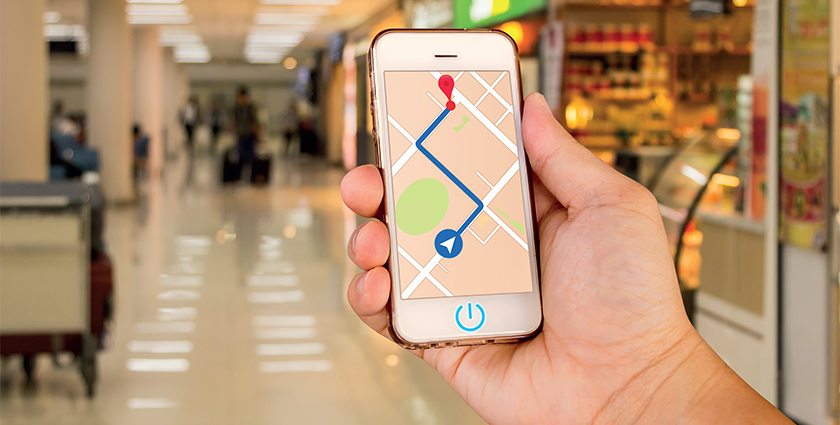
Where am I?
Whatever we might see in the movies, in real life, satellite technology is not very good at picking up phone frequencies from within buildings. You may well have experienced moments when you’ve wished you had a sat-nav for indoors: perhaps when in a sprawling airport (74 percent of travelers report having had a bad experience trying to find their gate); or in a gargantuan shopping mall (69 percent of customers who visit a shopping mall get lost at least three times); or even a massive office building (arriving late and flustered to meetings can result in stressed clients and ramshackle presentations). The good news is … the technology you dream of does exist: it’s called indoor digital wayfinding. And it could also help customers navigate around retail outlets and retail parks.
Wayfinding helps people navigate from one section of a physical space to another area in that space via effective communication of relevant information. In addition, wayfinding should also augment someone’s experience of the environment and increase their understanding of the space they are moving through.
So, for retailers wayfinding is doing its job if customers …
- know where they are
- know where they want to be
- have an effective route to their destination
- can easily recognize that destination when they reach it
- and, importantly, know how to find their way back
Traditional wayfinding is delivered through signage and on-wall maps: the classic ‘you are here’ arrow or dot. However, there are limits to its effectiveness, particularly in an environment where products are often moved around or replaced with others (for example, seasonal goods/items).
How does digital wayfinding work?
Indoor wayfinding uses a system of BLE Beacons, Wi-Fi signals, and the Earth’s magnetic field to pinpoint the person’s location, giving them real-time directions, both spoken and visual, to allow them to navigate through a business space, both horizontally and vertically.
A customer would open an app on their phone and key in the location they want.The app then calculates a route from their current location to the point in the building or center they need: it shows a map of the location, and their route is clearly marked. Just like traditional car sat-nav systems they then press ‘start’ and the app visually shows them where to head and audibly advises them.
As they progress along the route the app constantly updates showing them where they are and giving them regular voice and visual updates to show them where and when to turn, go straight-on, or change floors. It will also let the person know when they have arrived at their destination. However, unlike car sat-nav the system is accurate to one-to-two meters as the ‘sensors’ are within the building (not 12,000 miles away in space).
This means it can take a person direct to the desired section within a retail outlet.
Frustrated customers, wandering around aimlessly looking for specific services or brands, or not knowing which services and brands are available is not good for business. Employing digital wayfinding can help reduce the number of lost shoppers, plus boost footfall: for example, a 41 percent increase in footfall has been attributed to wayfinding technologies in shopping malls.
Additional data availability
There are advantages to retail businesses beyond keeping customers happy; digital wayfinding technology can gather extremely useful anonymous navigation data:
- How do people move around your outlet?
- Where does your outlet get the highest footfall?
- What route do they take to the car park or to public transport?
- If your business includes a café (or similar), when are people most likely to buy food?
- Data can help answer all of these questions and many more. Retailers can use this data to optimize their environments to improve the user experience, save money, and make the most of their retail spaces.
If an event is being planned in your business space (perhaps a concert by a local school to raise money for charity), data can help determine the ideal location to host the event that will cause the minimum of disruption and/or identify the areas with the type of footfall that is most appropriate for the event.
Data can allow businesses to optimize their environments and also their resources. If you need a piece of equipment or technology, but it’s not where it should be, location data can help you track it down. Perhaps you find that some equipment is regularly being transported long distances around your business environment, in which case you can judge if it would save time and money to buy a second machine/item.
Whether a business needs to move people (customers, clients or staff) from A to B efficiently, or make the most of their business space, using real-time data improves the chances of that business meeting (or exceeding) its goals. These benefits help to increase and control the flow within business environments and allows data to be transformed into valuable insights, to drive business forward. Digital wayfinding is a gateway to the future and also the tool that will guide you there. And these days almost every customer has the kit they need to take advantage of this new technology – people have to make a real effort to buy a phone that isn’t capable of providing detailed information about your business space.
For a list of the sources used in this article, please contact the editor.
 Joe Fernandes
Joe Fernandes
Joe Fernandes is founder and CEO of BuzzStreets, an award-winning navigation platform, that enables organizations (hospitals, shopping malls, airports, offices, stadiums, etc.) to offer their customers an indoor way-finder that allows them to navigate inside the building. The client arrives at the entrance or reception and then uses the bespoke app to navigate to the specific location (room, shop, check-in, office, or even seat) they need. BuzzStreets also supplies movement analytics that can help improve building efficiency and keep track of vital equipment.
www.buzzstreets.com